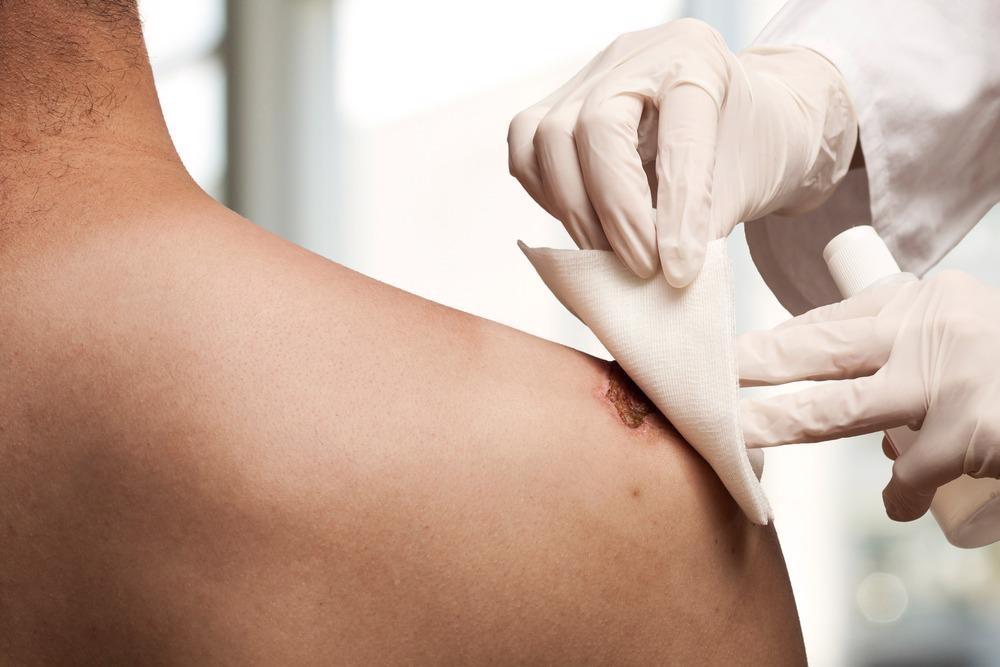An exciting advancement in wound healing research has come to light detailing multifunctional bilayered dermal patches with anti-inflammatory properties. This research was published in the journal Nanomedicine: Nanotechnology, Biology and Medicine, where researchers developed dermal patches that could potentially provide an improved, affordable and biodegradable solution for wound dressings, revolutionizing the field of skin regeneration.

Study: Novel combination of bioactive agents in bilayered dermal patches provides superior wound healing. Image Credit: Impact Photography/Shutterstock.com
Developing Multifunctional Bilayered Dermal Patches
Various wound healing agents were combined to create the patches, utilizing solvent casting and electrospinning techniques. Reported advantages include optimum wound exudate adsorption, anti-inflammation, antioxidant and antibacterial properties.
Researchers found patches to display enhanced fibroblast cell migration and superior wound healing in rats. Fibroblasts play a critical role in wound healing, helping to maintain homeostasis of the extracellular matrix, which can aid in re-epithelization and restoring the functionality of damaged tissue.
This novel dermal patch includes a top layer that is made up of polycaprolactone (PCL) and chitosan (CS), as well as a bottom layer that consists of polyvinyl alcohol (PVA) encompassing wound healing agents such as curcumin nanoparticles and soluble eggshell membrane.
Wound Healing Issues
As the skin is the largest organ in the body, effective wound healing treatments are an area of research continually evolving and advancing.
The wound healing process includes four stages: hemostasis, inflammation, proliferation, and remodeling, which can be summarized as follows: the formation of the platelet plug, vasodilation, and the aggregation of immune cells to prevent infection. Next is the growth of new granulation tissue and scar formation, which can take months or even years. Finally, the granulation tissue starts to mature.
Having an advanced wound healing strategy would optimize this process to ensure infections are prevented, inflammation is reduced, and healing is enhanced.
Wound dressings are one potential option being explored. Patches could enhance adsorption of excess wound exudate, create a microbial barrier while being non-toxic to the patient, and have the additional benefit of being degradable.
There are currently 3000 different wound healing dressings available on the market; however, they do not all achieve the same level of healing and must be selected depending on the type of wound.
Chronic wounds can take longer to heal, and those like venous ulcers, pressure ulcers, and burn and diabetic wounds are also difficult to treat. Still, the use of an advanced wound care system as explored within this research would be hugely beneficial, targeting inflammation and supplying the affected area with antioxidant agents.
The Novel Wound Dressing
The wound dressing proposed by the research team includes PCL, which is FDA approved and is a hydrophobic biodegradable polymer and can be found ubiquitously within tissue engineering applications.
The polymer chitosan (FDA approved) was included due to its antibacterial and biodegradable characteristics. This combination served as a hydrophobic layer for optimal water vapor transmission rate and provided a microbial barrier for advanced wound healing.
PVA was utilized as a hydrogel matrix. It also encompassed the critical wound healing agents as well as an absorbent for the wound exudate, which was integral for providing a moist environment for the wound.
The wound healing agents consisted of curcumin, a polyphenol that is an active component present in turmeric. Curcumin has potent wound healing characteristics such as antioxidants and has antibacterial and anti-inflammatory properties.
Researchers also used an eggshell membrane, the thin layer between the egg white and shell, which is highly proteinaceous and provides a high volume of collagen and other proteoglycans.
This layer has been used previously and commonly in Asian countries; however, the low processability of the layer limits its accessibility, which is unfortunate due to being similar in composition to human tissue.
Animal models indicated the dermal skin patches to be effective in healing rat skin excision wounds. Furthermore, patches supported the generation of extracellular matrix proteins for wound healing, complete wound closure, reduced epidermal thickness, and enhanced collagen.
Future Work
While this research showed promising characteristics for the adsorption of wound exudates and the anti-inflammatory and antimicrobial effects on the wound site, there would need to be further mass-scale research in vivo to assess its ability to be a translational medical product.
These investigations have demonstrated the exciting potential curcumin, and soluble eggshell membranes have in wound healing, which could form the basis of a promising novel wound dressing in the future.
Continue reading: NANO-LLPO: Using Nanomaterials to Heal Wounds.
Reference
Pillai, M., Dandia, H., Checker, R., Rokade, S., Sharma, D. and Tayalia, P., (2021) Novel combination of bioactive agents in bilayered dermal patches provides superior wound healing. Nanomedicine: Nanotechnology, Biology and Medicine, p.102495. Available at: https://www.sciencedirect.com/science/article/pii/S1549963421001386
Disclaimer: The views expressed here are those of the author expressed in their private capacity and do not necessarily represent the views of AZoM.com Limited T/A AZoNetwork the owner and operator of this website. This disclaimer forms part of the Terms and conditions of use of this website.